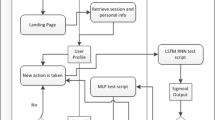Abstract
The collaborative filtering (CF) technique has been widely used recently in recommendation systems. It needs historical data to give predictions. However, the data sparsity problem still exists. We propose a new item-based restricted Boltzmann machine (RBM) approach for CF and use the deep multilayer RBM network structure, which alleviates the data sparsity problem and has excellent ability to extract features. Each item is treated as a single RBM, and different items share the same weights and biases. The parameters are learned layer by layer in the deep network. The batch gradient descent algorithm with minibatch is used to increase the convergence speed. The new feature vector discovered by the multilayer RBM network structure is very effective in predicting a rating and achieves a better result. Experimental results on the data set of MovieLens show that the item-based multilayer RBM approach achieves the best performance, with a mean absolute error of 0.6424 and a root-mean-square error of 0.7843.
Similar content being viewed by others
References
Bell, R., Koren, Y., Volinsky, C., 2007. The BellKor Solution to the Netfix Prize. http://netflixprize.com/assets/GrandPrize2009_BPC_Bell Kor.pdf
Bengio, Y., 2009. Learning deep architectures for AI. Found. Trends Mach. Learn., 2(1):1–127. http://dx.doi.org/10.1561/2200000006
Breese, J., Hecherman, D., Kadie, C., 1998. Empirical analysis of predictive algorithms for collaborative filtering. Proc. 14th Conf. on Uncertainty in Artificial Intelligence, p.43–52.
Candès, E.J., Recht, B., 2009. Exact matrix completion via convex optimization. Found. Comput. Math., 9(6):717–772. http://dx.doi.org/10.1007/s10208-009-9045-5
Ference, G., Ye, M., Lee, W.C., 2013. Location recommendation for out-of-town users in location-based social networks. Proc. 22nd ACM Int. Conf. on Information & Knowledge Management, p.721–726. http://dx.doi.org/10.1145/2505515.2505637
Feuerverger, A., He, Y., Khatri, S., 2012. Statistical significance of the Netflix challenge. Stat. Sci., 27(2):202–231. http://dx.doi.org/10.1214/11-STS368
Hinton, G.E., 2002. Training products of experts by minimizing contrastive divergence. Neur. Comput., 14(8):1771–1800. http://dx.doi.org/10.1162/089976602760128018
Hinton, G.E., Sejnowski, J., 1983. Optimal perceptual inference. Proc. IEEE Conf. on Computer Vision and Pattern Recognition, p.448–453.
Hinton, G.E., Osindero, S., Teh, Y.W., 2006. A fast learning algorithm for deep belief nets. Neur. Comput., 18(7):1527–1554. http://dx.doi.org/10.1162/neco.2006.18.7.1527
Koren, Y., Bell, R., Volinsky, C., 2009. Matrix factorization techniques for recommender systems. Computer, 42(8):30–37. http://dx.doi.org/10.1109/MC.2009.263
Li, Y., Yang, M., Zhang, Z.M., 2013. Scientific articles recommendation. Proc. 22nd ACM Int. Conf. on Information & Knowledge Management, p.1147–1156. http://dx.doi.org/10.1145/2505515.2505705
Linden, G., Smith, B., York, J., 2003. Amazon.com recommendations: item-to-item collaborative filtering. IEEE Int. Comput., 7(1):76–80. http://dx.doi.org/10.1109/MIC.2003.1167344
Luo, H., 2011. Restricted Boltzmann Machines: a Collaborative Filtering Perspective. PhD Thesis, Shanghai Jiao Tong University, Shanghai, China (in Chinese).
Mohamed, A., Dahl, G.E., Hinton, G.E., 2012. Acoustic modeling using deep belief networks. IEEE Trans. Audio Speech Lang. Process., 20(1):14–22. http://dx.doi.org/10.1109/TASL.2011.2109382
Nathanson, T., Bitton, E., Goldberg, K., 2007. Eigentaste 5.0: constant-time adaptability in a recommender system using item clustering. Proc. ACM Conf. on Recommender Systems, p.149–152. http://dx.doi.org/10.1145/1297231.1297258
Resnick, P., Iacovou, N., Suchak, M., et al., 1994. GroupLens: an open architecture for collaborative filtering of netnews. Proc. ACM Conf. on Computer Supported Cooperative Work, p.175–186. http://dx.doi.org/10.1145/192844.192905
Salakhutdinov, R., Mnih, A., Hinton, G.E., 2007. Restricted Boltzmann machines for collaborative filtering. Proc. 24th Annual Int. Conf. on Machine Learning, p.791–798. http://dx.doi.org/10.1145/1273496.1273596
Sarwar, B., Karypis, G., Konstan, J., et al., 2001. Item-based collaborative filtering recommendation algorithms. Proc. ACM 10th Int. Conf. on World Wide Web, p.285–295. http://dx.doi.org/10.1145/371920.372071
Schafer, J.B., Konstan, J., Riedl, J., 1999. Recommender systems in E-commerce. Proc. 1st ACM Conf. on Electronic Commerce, p.158–166. http://dx.doi.org/10.1145/336992.337035
Shi, J., Chen, J., Bao, Z., 2011. An application study on collaborative filtering in e-commerce. Int. Conf. on Service Systems and Service Management, p.1–7. http://dx.doi.org/10.1109/ICSSSM.2011.5959336
Smolensky, P., 1986. Information processing in dynamical systems: foundations of harmony theory. In: Rumellhart, D.E., McClelland, J.L. (Eds.), Parallel Distributed Processing: Explorations in the Microstructure of Cognition. Vol. 1: Foundations. MIT Press, Cambridge, MA,USA, p.194–281.
Töscher, A., Jahrer, M., 2008. The BigChaos Solution to the Netfix Prize 2008. http://netflixprize.com/assets/GrandPrize2009_BPC_Big Chaos.pdf
Wang, S., Tang, J., Wang, Y., 2015. Exploring implicit hierarchical structures for recommender systems. Proc. 24th Int. Joint Conf. on Artificial Intelligence, p.1813–1819.
Wu, J.L., 2010. Collaborative Filtering on the Netflix Prize Dataset. PHD Thesis, Peking University, Beijing, China (in Chinese).
Zhang, C.X., Ji, N.N., Wang, G.W., 2015. Restricted Boltzman machines. Chin. J. Eng. Math., 32(2):159–173 (in Chinese). http://dx.doi.org/10.3969/j.issn.1005-3085.2015.02.001
Zhang, M., Tang, J., Zhang, X., et al., 2014. Addressing cold start in recommender systems: a semi-supervised cotraining algorithm. Proc. 37th Int. ACM SIGIR Conf. on Research and Development in Information Retrieval, p.73–82. http://dx.doi.org/10.1145/2600428.2609599
Author information
Authors and Affiliations
Corresponding author
Additional information
Project supported by the National Science and Technology Support Plan (No. 2013BAH21B02-01) and the Beijing Natural Science Foundation (No. 4153058)
ORCID: Yong-ping DU, http://orcid.org/0000-0001-6867-2063
Rights and permissions
About this article
Cite this article
Du, Yp., Yao, Cq., Huo, Sh. et al. A new item-based deep network structure using a restricted Boltzmann machine for collaborative filtering. Frontiers Inf Technol Electronic Eng 18, 658–666 (2017). https://doi.org/10.1631/FITEE.1601732
Received:
Accepted:
Published:
Issue Date:
DOI: https://doi.org/10.1631/FITEE.1601732




